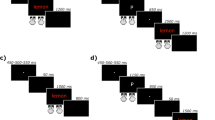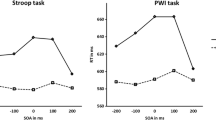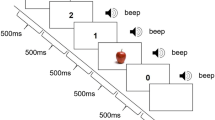Abstract
The so-called semantic interference effect is a delay in selecting an appropriate target word in a context where semantic neighbours are strongly activated. Semantic interference effect has been described to vary from one individual to another. These differences in the susceptibility to semantic interference may be due to either differences in the ability to engage in lexical-specific selection mechanisms or to differences in the ability to engage more general, top-down inhibition mechanisms which suppress unwanted responses based on task-demands. However, semantic interference may also be modulated by an individual’s disposition to separate relevant perceptual signals from noise, such as a field-independent (FI) or a field-dependent (FD) cognitive style. We investigated the relationship between semantic interference in picture naming and in an STM probe task and both the ability to inhibit responses top-down (measured through a Stroop task) and a FI/FD cognitive style measured through the embedded figures test (EFT). We found a significant relationship between semantic interference in picture naming and cognitive style—with semantic interference increasing as a function of the degree of field dependence—but no associations with the semantic probe and the Stroop task. Our results suggest that semantic interference can be modulated by cognitive style, but not by differences in the ability to engage top-down control mechanisms, at least as measured by the Stroop task.






Similar content being viewed by others
References
Alario F-X, Martín FMDP (2010) On the origin of the “cumulative semantic inhibition” effect. Mem Cognit 38:57–66. https://doi.org/10.3758/MC.38.1.57
Aron AR (2007) The neural basis of inhibition in cognitive control. Neuroscientist 13:214–228. https://doi.org/10.1177/1073858407299288
Atkins AS, Reuter-Lorenz PA (2008) False working memories? Semantic distortion in a mere 4 s. Mem Cognit 36:74–81. https://doi.org/10.3758/MC.36.1.74
Atkins AS, Berman MG, Reuter-Lorenz PA et al (2011) Resolving semantic and proactive interference in memory over the short-term. Mem Cognit 39:806–817. https://doi.org/10.3758/s13421-011-0072-5
Baayen RH, Davidson DJ, Bates DM (2008) Mixed-effects modeling with crossed random effects for subjects and items. J Mem Lang 59:390–412. https://doi.org/10.1016/j.jml.2007.12.005
Banich MT, Milham MP, Atchley RA et al (2000) Prefrontal regions play a predominant role in imposing an attentional “set”: evidence from fMRI. Cogn Brain Res 10:1–9. https://doi.org/10.1016/S0926-6410(00)00015-X
Bates D, Kliegl R, Vasishth S, Baayen RH (2015a) Parsimonious mixed models. (arXiv:1506.04967)
Bates DM, Maechler M, Bolker B, Walker S (2015b) Fitting linear mixed-effects models using lme4. J Stat Softw 67:1–48. https://doi.org/10.1177/009286150103500418
Belke E, Stielow A (2013) Cumulative and non-cumulative semantic interference in object naming: evidence from blocked and continuous manipulations of semantic context. Q J Exp Psychol (Hove) 66:2135–2160. https://doi.org/10.1080/17470218.2013.775318
Belke E, Meyer AS, Damian MF (2005) Refractory effects in picture naming as assessed in a semantic blocking paradigm. Q J Exp Psychol A 58:667–692. https://doi.org/10.1080/02724980443000142
Berman MG, Jonides J, Lewis RL (2009) In search of decay in verbal short-term memory. J Exp Psychol Learn Mem Cogn 35:317–333. https://doi.org/10.1037/a0014873
Boccia M, Piccardi L, Marco M, Di et al (2016) Does field independence predict visuo-spatial abilities underpinning human navigation? Behavioural evidence. Exp Brain Res. https://doi.org/10.1007/s00221-016-4682-9
Borella E, Carretti B, De Beni R (2007) Accertamento della Memoria negli Adulti [The evaluation of memory in adulthood]. Organizzazioni Speciali, Firenze
Brown AS, Zoccoli SL, Leahy MM (2005) Cumulating retrieval inhibition in semantic and lexical domains. J Exp Psychol Learn Mem Cogn 31:496–507. https://doi.org/10.1037/0278-7393.31.3.496
Damian MF, Bowers JS (2003) Locus of semantic interference in picture-word interference tasks. Psychon Bull Rev 10:111–117. https://doi.org/10.3758/BF03196474
de Zubicaray GI, Wilson SJ, McMahon KL, Muthiah S (2001) The semantic interference effect in the picture-word paradigm: an event-related fMRI study employing overt responses. Hum Brain Mapp 14:218–227. https://doi.org/10.1002/hbm.1054
de Zubicaray G, McMahon K, Howard D (2013) Perfusion fMRI evidence for priming of shared feature-to-lexical connections during cumulative semantic interference in spoken word production. Lang Cogn Process 00:1–12. https://doi.org/10.1080/01690965.2013.848990
de Zubicaray G, De Johnson K, Howard D et al (2014) A perfusion fMRI investigation of thematic and categorical context effects in the spoken production of object names. Cortex 54:135–149. https://doi.org/10.1016/j.cortex.2014.01.018
Dell’Acqua R, Job R, Peressotti F, Pascali A (2007) The picture-word interference effect is not a Stroop effect. Psychon Bull Rev 14:717–722. https://doi.org/10.3758/BF03196827
Evans C, Richardson JTE, Waring M (2013) Field independence: Reviewing the evidence. Br J Educ Psychol 83:210–224. https://doi.org/10.1111/bjep.12015
Fagot C, Pashler H (1992) Making Two Responses to a Single Object: Implications for the Central Attentional Bottleneck. J Exp Psychol Hum Percept Perform. https://doi.org/10.1037/0096-1523.18.4.1058
Faul F, Erdfelder E, Buchner A, Lang A-G (2009) Statistical power analyses using G*Power 3.1: Tests for correlation and regression analyses. Behav Res Methods 41:1149–1160
Fogliani Messina TM, Fogliani AM, Di Nuovo S (1984) Dipendenza dal campo e stile cognitivo: gli Embedded figures tests di H. Wit- kin, P. K. Oltman, E. Raskine, S. A. Karp. Organizzazioni speciali, Firenze
Friedman NP, Miyake A (2004) The relations among inhibition and interference control functions: a latent-variable analysis. J Exp Psychol Gen 133:101–135. https://doi.org/10.1037/0096-3445.133.1.101
Goslin J, Galluzzi C, Romani C (2014) PhonItalia: a phonological lexicon for Italian. Behav Res Methods 46:872–886. https://doi.org/10.3758/s13428-013-0400-8
Gurd JM, Oliveira RM (1996) Competitive inhibition models of lexical-semantic processing: experimental evidence. Brain Lang 54:414–433. https://doi.org/10.1006/brln.1996.0083
Hamilton AC, Martin RC (2007) Proactive interference in a semantic short-term memory deficit: role of semantic and phonological relatedness. Cortex 43:112–123. https://doi.org/10.1016/S0010-9452(08)70449-0
Howard D, Nickels L, Coltheart M, Cole-Virtue J (2006) Cumulative semantic inhibition in picture naming: experimental and computational studies. Cognition 100:464–482. https://doi.org/10.1016/j.cognition.2005.02.006
Khng KH, Lee K (2014) The relationship between stroop and stop-signal measures of inhibition in adolescents: Influences from variations in context and measure estimation. PLoS One. https://doi.org/10.1371/journal.pone.0101356
Krieger-Redwood K, Jefferies E (2014) TMS interferes with lexical-semantic retrieval in left inferior frontal gyrus and posterior middle temporal gyrus: Evidence from cyclical picture naming. Neuropsychologia 64:24–32. https://doi.org/10.1016/j.neuropsychologia.2014.09.014
Lang A, Dhillon K, Dong Q (1995) The effects of emotional arousal and valence on television viewers’ cognitive capacity and memory. J Broadcast Electron Media 39:313–327. https://doi.org/10.1080/08838159509364309
Likert R, Quasha WH (1941) Revised minnesota paper form board. Psychological Corporation, New York
Milham MP, Banich MT, Webb A et al (2001) The relative involvement of anterior cingulate and prefrontal cortex in attentional control depends on nature of conflict. Cogn Brain Res 12:467–473. https://doi.org/10.1016/S0926-6410(01)00076-3
Milham MP, Erickson KI, Banich MT et al (2002) Attentional control in the aging brain: Insights from an fMRI study of the stroop task. Brain Cogn 49:277–296. https://doi.org/10.1006/brcg.2001.1501
Milham MP, Banich MT, Barad V (2003) Competition for priority in processing increases prefrontal cortex’s involvement in top-down control: an event-related fMRI study of the stroop task. Image Process 17:212–222
Mitolo M, Gardini S, Fasano F et al (2013) Visuospatial memory and neuroimaging correlates in mild cognitive impairment. J Alzheimer’s Dis 35:75–90. https://doi.org/10.3233/JAD-121288
Miyake A, Friedman NP, Emerson MJ et al (2000) The unity and diversity of executive functions and their contributions to complex “Frontal Lobe” tasks: a latent variable analysis. Cogn Psychol 41:49–100. https://doi.org/10.1006/cogp.1999.0734
Munakata Y, Herd SA, Chatham CH et al (2011) A unified framework for inhibitory control. Trends Cogn Sci 15:453–459. https://doi.org/10.1016/j.tics.2011.07.011
Nakagawa S, Schielzeth H (2013) A general and simple method for obtaining R2 from generalized linear mixed-effects models. Methods Ecol Evol 4:133–142. https://doi.org/10.1111/j.2041-210x.2012.00261.x
Navarrete E, Mahon BZ, Caramazza A (2010) The cumulative semantic cost does not reflect lexical selection. Acta Psychol (Amst) 134:279–289. https://doi.org/10.1016/j.actpsy.2010.02.009.The
Navon D (1977) Forest before trees: the precedence of global features in visual perception. Cogn Psychol 9:353–383. https://doi.org/10.1016/0010-0285(77)90012-3
Nigg JT (2000) On inhibition/disinhibition in developmental psychopathology: views from cognitive and personality psychology and a working inhibition taxonomy. Psychol Bull 126:220–246. https://doi.org/10.1037/0033-2909.126.2.220
Noreen S, MacLeod MD, Kim F (2015) What do we really know about cognitive inhibition? Task demands and inhibitory effects across a range of memory and behavioural tasks. PLoS One 10:1–21. https://doi.org/10.1371/journal.pone.0134951
Novick JM, Kan IP, Trueswell JC, Thompson-Schill SL (2009) A case for conflict across multiple domains: memory and language impairments following damage to ventrolateral prefrontal cortex
Nozari AY, Siamian H (2015) the relationship between field dependent-independent cognitive style and understanding of English text reading and academic success. Mater Sociomed 27:39–41. https://doi.org/10.5455/msm.2014.27.39-41
Oppenheim GM, Dell GS, Schwartz MF (2010) The dark side of incremental learning: a model of cumulative semantic interference during lexical access in speech production. Cognition 114:227–252. https://doi.org/10.1016/j.cognition.2009.09.007
Piai V, Roelofs A, Schriefers H (2012) Distractor strength and selective attention in picture-naming performance. Mem Cognit 40:614–627. https://doi.org/10.3758/s13421-011-0171-3
Poirel N, Pineau A, Jobard G, Mellet E (2008) Seeing the forest before the trees depends on individual field-dependency characteristics. Exp Psychol 55:328–333. https://doi.org/10.1027/1618-3169.55.5.328
Ridderinkhof KR, Scheres A, Oosterlaan J, Sergeant JA (2005) Delta plots in the study of individual differences: new tools reveal response inhibition deficits in AD/Hd that are eliminated by methylphenidate treatment. J Abnorm Psychol 114:197–215. https://doi.org/10.1037/0021-843X.114.2.197
Rittschof KA (2010) Field dependence-independence as visuospatial and executive functioning in working memory: Implications for instructional systems design and research. Educ Technol Res Dev 58:99–114. https://doi.org/10.1007/s11423-008-9093-6
Rose SB, Abdel Rahman R (2016) Cumulative semantic interference for associative relations in language production. Cognition 152:20–31. https://doi.org/10.1016/j.cognition.2016.03.013
Rose SB, Abdel Rahman R (2017) Semantic similarity promotes interference in the continuous naming paradigm: behavioural and electrophysiological evidence. Lang Cogn Neurosci 32:55–68. https://doi.org/10.1080/23273798.2016.1212081
Runnqvist E, Strijkers K, Alario FX, Costa A (2012) Cumulative semantic interference is blind to language: Implications for models of bilingual speech production. J Mem Lang 66:850–869. https://doi.org/10.1016/j.jml.2012.02.007
Schaalje GB, McBride JB, Fellingham GW (1997) Approximations to distributions of test statistics in complex mixed linear models using SAS ® Proc MIXED. In: Proceedings of twenty-sixth Annu SAS® Users Gr international conference paper, pp 262–26
Schnur TT (2014) The persistence of cumulative semantic interference during naming. J Mem Lang 75:27–44. https://doi.org/10.1016/j.jml.2014.04.006
Schnur TT, Schwartz MF, Brecher A, Hodgson C (2006) Semantic interference during blocked-cyclic naming: Evidence from aphasia. J Mem Lang 54:199–227. https://doi.org/10.1016/j.jml.2005.10.002
Shao Z, Meyer AS, Roelofs A (2013) Selective and nonselective inhibition of competitors in picture naming. Mem Cognit 41:1200–1211. https://doi.org/10.3758/s13421-013-0332-7
Shao Z, Roelofs A, Martin RC, Meyer AS (2015) Selective inhibition and naming performance in semantic blocking, picture-word interference, and color–word Stroop tasks. J Exp Psychol Learn Mem Cogn 41:1806–1820. https://doi.org/10.1037/a0039363
St Clair-Thompson H, Overton T, Botton C (2010) Information processing: a review of implications of Johnstone’s model for science education. Res Sci Technol Educ 28:131–148. https://doi.org/10.1080/02635141003750479
Thompson-Schill SL, D’Esposito M, Kan IP (1999) Effects of repetition and competition activity from prefrontal cortex in executive control of memory retrieval. Neuron 23:513–522
Vigliocco G, Vinson DP, Damian MF, Levelt W (2002) Semantic distance effects on object and action naming. 85:61–69
Vigliocco G, Vinson DP, Lewis W, Garrett MF (2004) Representing the meanings of object and action words: the featural and unitary semantic space hypothesis. Cogn Psychol 48:422–488. https://doi.org/10.1016/j.cogpsych.2003.09.001
Whitney C, Kirk M, O’Sullivan J et al (2011) The neural organization of semantic control: TMS evidence for a distributed network in left inferior frontal and posterior middle temporal gyrus. Cereb Cortex 21:1066–1075. https://doi.org/10.1093/cercor/bhq180
Witkin HA, Goodenough DR (1981) Cognitive styles: essence and origins. International Universities Press, New York
Witkin HA, Oltman PK, Raskin E, Karp S (1971) A manual for the embedded figures test. Consulting psychologists press, Palo Alto
Witkin HA (1977) Cognitive style in personal and cultural adaptation. Field-dependent and field-independent cognitive styles and their educational implications, vol 47. Clark University Press, Worcester, MA, pp 1–64
Witkin HA, Moore CA, Goodenough DR, Cox PW (1977) Field-development and field-independent cognitive styles and their educational implications. Rev Educ Res 47:1–64
Author information
Authors and Affiliations
Corresponding author
Additional information
Publisher’s Note
Springer Nature remains neutral with regard to jurisdictional claims in published maps and institutional affiliations.
Appendices
Appendices
Appendix 1: Stimuli for continuous picture naming
Body parts: arm (braccio), ear (orecchio), foot (piede), hand (mano), leg (gamba).
Clothing items: dress (vestito), shirt (camicia), skirt (gonna), sweater (maglione), trousers (pantaloni).
Fruits: banana (banana), pineapple (ananas), strawberry (fragola), grapes (uva), pear (pera).
Furniture: chair (sedia), sofa (divano), desk (scrivania), table (tavolo), bed (letto).
Insects: butterfly (farfalla), spider (ragno), fly (mosca), ant (formica), mosquito (zanzara).
Instruments: drum (tamburo), trumpet (tromba), violin (violino), guitar (chitarra), piano (pianoforte).
Kitchen utensil: pan (padella), knife (coltello), fork (forchetta), spoon (cucchiaio), plate (piatto).
Plants: flower (fiore), leaf (foglia), palm tree (palma), tree (albero), cactus (cactus).
Tools: hammer (martello), pliers (pinze), saw (sega), drill (trapano), screwdriver (giravite).
Transport: aeroplane (aereo), car (auto), train (treno), motorbike (moto), boat (barca).
White goods: toaster (tostapane), blender (frullatore), refrigerator (frigorifero), washing machine (lavatrice), radio (radio).
Zoo animals: elephant (elefante), panda (panda), monkey (scimmia), gorilla (gorilla), giraffe (giraffa).
Appendix 2: Stimulus statistics for the continuous picture naming tasks; frequency and length from CoLFIS database (Goslin et al. 2014)
Position | Total | |||||||||||
|---|---|---|---|---|---|---|---|---|---|---|---|---|
1 | 2 | 3 | 4 | 5 | M | SD | ||||||
M | SD | M | SD | M | SD | M | SD | M | SD | |||
Frequency | 51 | 40 | 52 | 74 | 70 | 70 | 50 | 49 | 64 | 60 | 58 | 59 |
Length | 7 | 2 | 6 | 2 | 7 | 2 | 7 | 2 | 7 | 2 | 7 | 2 |
Rights and permissions
About this article
Cite this article
Nappo, R., Romani, C., De Angelis, G. et al. Cognitive style modulates semantic interference effects: evidence from field dependency. Exp Brain Res 237, 755–768 (2019). https://doi.org/10.1007/s00221-018-5457-2
Received:
Accepted:
Published:
Issue Date:
DOI: https://doi.org/10.1007/s00221-018-5457-2




